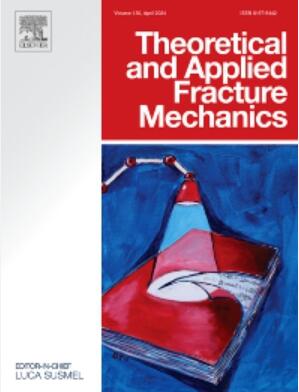A fourth-order phase-field model of crack initiation and propagation under thermomechanical loading solved with strong-form meshless method
IF 5
2区 工程技术
Q1 ENGINEERING, MECHANICAL
引用次数: 0
Abstract
This study aims to develop a combination of the fourth-order phase-field method (PFM) and a strong-form meshless solution procedure for crack initiation and propagation under thermomechanical loading in two-dimensional brittle elastic material. The formulation involves thermal, mechanical and fourth-order phase-field equations. A spectral-split method decomposes the elastic strain tensor for physically correct crack propagation under mixed-mode thermomechanical loading conditions. The three coupled equations are solved in a staggered form. The domain discretization is based on regular or scattered nodes, overlapping subdomain division of the domain, and interpolation of the involved subdomain fields using third-order polyharmonic splines combined with second-order polynomial augmentation. The three numerical benchmarks include the pure thermal case, single-edge crack propagation under combined thermomechanical loading and quenching. The suitability and robustness of the proposed meshless approach are demonstrated on both regular and scattered node arrangements, and the corresponding second-order h-convergence of the displacement fields was shown for the subdomains with 13 nodes. The scattered node arrangement more effectively captures crack propagation under complex loading conditions. The originality of this study is twofold. It represents a pioneering approach using the fourth-order PFM to the thermomechanical brittle elastic system and the first solution to the related physical situation by a meshless method. The proposed method possesses a strong performance in terms of accuracy. The required dense node arrangement around the crack influences its computational efficiency. Further study will include an adaptive node arrangement scheme to enhance computational efficiency, enabling the extension to three dimensions.
采用强形式无网格法求解了热载荷作用下裂纹萌生与扩展的四阶相场模型
本研究旨在结合四阶相场法(PFM)和强形式无网格求解方法,研究二维脆性弹性材料在热载荷作用下裂纹的萌生和扩展。该公式包括热、力学和四阶相场方程。采用谱分裂方法对弹性应变张量进行分解,使裂纹在混合模态热载荷条件下物理正确地扩展。三个耦合方程以交错形式求解。区域离散是基于规则节点或分散节点,重叠子域划分,以及使用三阶多谐样条结合二阶多项式增广对涉及的子域域进行插值。三个数值基准包括纯热情况、复合热载荷下单边裂纹扩展和淬火。结果表明,该方法在规则节点布置和分散节点布置下均具有较好的适用性和鲁棒性,对于13个节点的子域,位移场具有相应的二阶h收敛性。分散的节点排列更有效地捕捉了复杂加载条件下的裂纹扩展。这项研究的独创性是双重的。这是将四阶PFM应用于热脆弹性系统的开创性方法,也是首次采用无网格方法解决相关物理情况。该方法在精度方面具有较强的性能。裂纹周围所需的密集节点排列影响其计算效率。进一步的研究将包括自适应节点排列方案,以提高计算效率,使扩展到三维空间。
本文章由计算机程序翻译,如有差异,请以英文原文为准。
求助全文
约1分钟内获得全文
求助全文
来源期刊

Theoretical and Applied Fracture Mechanics
工程技术-工程:机械
CiteScore
8.40
自引率
18.90%
发文量
435
审稿时长
37 days
期刊介绍:
Theoretical and Applied Fracture Mechanics'' aims & scopes have been re-designed to cover both the theoretical, applied, and numerical aspects associated with those cracking related phenomena taking place, at a micro-, meso-, and macroscopic level, in materials/components/structures of any kind.
The journal aims to cover the cracking/mechanical behaviour of materials/components/structures in those situations involving both time-independent and time-dependent system of external forces/moments (such as, for instance, quasi-static, impulsive, impact, blasting, creep, contact, and fatigue loading). Since, under the above circumstances, the mechanical behaviour of cracked materials/components/structures is also affected by the environmental conditions, the journal would consider also those theoretical/experimental research works investigating the effect of external variables such as, for instance, the effect of corrosive environments as well as of high/low-temperature.
 求助内容:
求助内容: 应助结果提醒方式:
应助结果提醒方式:


